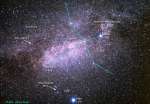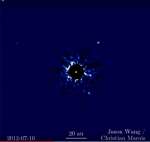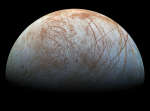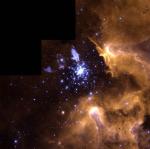
|
You entered: life
 Where is HD 189733
Where is HD 189733
20.03.2008
The star cataloged as HD 189733 is a mere 63 light-years away. Its location is indicated in this deep, wide-angle image of the sky centered on the northern constellation of Cygnus. Considering the many...
 Galileo Explores Europa
Galileo Explores Europa
14.08.1996
Details of the crazed cracks criss-crossing Europa's frozen surface are apparent in this mosaic of the Galileo spacecraft's latest images of Jupiter's ice-covered moon. Curious white stripes, also seen by Voyager, are clearly visible marking the center of the wide dark fractures.
 APOD: 2024 July 1 Б Time Spiral
APOD: 2024 July 1 Б Time Spiral
30.06.2024
What's happened since the universe started? The time spiral shown here features a few notable highlights. At the spiral's center is the Big Bang, the place where time, as we know it, began about 13.8 billion years ago.
 Artistic Impression: The Surface of TRAPPIST 1f
Artistic Impression: The Surface of TRAPPIST 1f
25.06.2017
If you could stand on the surface of the newly discovered Earth-sized exoplanet TRAPPIST-1f, what would you see? Presently, no Earthling knows for sure, but the featured illustration depicts a reasoned guess based on observational data taken by NASA's Sun-orbiting Spitzer Space Telescope.
 Four Planets Orbiting Star HR 8799
Four Planets Orbiting Star HR 8799
31.01.2017
Does life exist outside our Solar System? To help find out, NASA has created the Nexus for Exoplanet System Science (NExSS) to better locate and study distant star systems that hold hope of harboring living inhabitants.
 Galileo s Europa
Galileo s Europa
28.03.2024
Looping through the Jovian system in the late 1990s, the Galileo spacecraft recorded stunning views of Europa and uncovered evidence that the moon's icy surface likely hides a deep, global ocean. Galileo...
 Layered Mars: An Ancient Water World
Layered Mars: An Ancient Water World
4.12.2000
Pictured above, layers upon layers stretch across the floor of West Candor Chasma within the immense martian Valles Marineris. Covering an area 1.5 by 2.9 kilometers, the full image from the Mars Global Surveyor spacecraft shows over 100 individual beds.
 Salt Water Remnants on Ceres
Salt Water Remnants on Ceres
31.08.2020
Does Ceres have underground pockets of water? Ceres, the largest asteroid in the asteroid belt, was thought to be composed of rock and ice. At the same time, Ceres was known to have unusual bright spots on its surface. These bright spots were clearly imaged during Dawn's exciting approach in 2015.
 APOD: 2023 September 4 Б Cygnus: Bubble and Crescent
APOD: 2023 September 4 Б Cygnus: Bubble and Crescent
3.09.2023
As stars die, they create clouds. Two stellar death clouds of gas and dust can be found toward the high-flying constellation of the Swan (Cygnus) as they drift through rich star fields in the plane of our Milky Way Galaxy.
 NGC 3603: From Beginning To End
NGC 3603: From Beginning To End
4.06.1999
From beginning to end, different stages of a star's life appear in this exciting Hubble Space Telescope picture of the environs of galactic emission nebula NGC 3603. For the beginning, eye-catching "pillars" of glowing hydrogen at the right signal newborn stars emerging from their dense, gaseous, nurseries.
|
January February March April May June July |
|||||||||||||||||||||||||||||||||||||||||||||||||